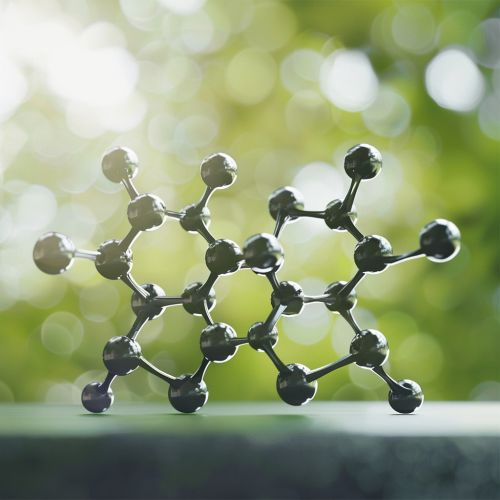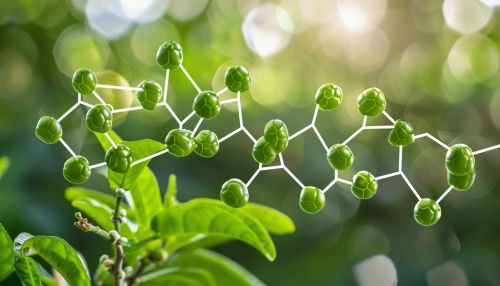Zingiberene: Difference between revisions
(Created page with "== Introduction == Zingiberene is a naturally occurring sesquiterpene, a class of terpenes that consists of three isoprene units. It is a major constituent of the essential oil derived from the rhizomes of ginger (Zingiber officinale). Zingiberene is known for its distinctive spicy aroma and is a key contributor to the characteristic scent and flavor of ginger. This compound has garnered significant interest due to its various biological activities, including antimicrob...") |
No edit summary |
||
| Line 7: | Line 7: | ||
Zingiberene is a hydrocarbon with the molecular formula C15H24. It belongs to the class of sesquiterpenes, which are characterized by their 15-carbon skeleton. The structure of zingiberene includes a bicyclic ring system, which contributes to its stability and reactivity. The compound exists in several stereoisomeric forms, with the most common being (−)-zingiberene. | Zingiberene is a hydrocarbon with the molecular formula C15H24. It belongs to the class of sesquiterpenes, which are characterized by their 15-carbon skeleton. The structure of zingiberene includes a bicyclic ring system, which contributes to its stability and reactivity. The compound exists in several stereoisomeric forms, with the most common being (−)-zingiberene. | ||
[[Image:Detail-91253.jpg|thumb|center|Chemical structure of zingiberene.|class=only_on_mobile]] | |||
[[Image:Detail-91254.jpg|thumb|center|Chemical structure of zingiberene.|class=only_on_desktop]] | |||
The physical properties of zingiberene include a boiling point of approximately 255°C and a density of around 0.88 g/cm³. It is a colorless to pale yellow liquid at room temperature and is insoluble in water but soluble in organic solvents such as ethanol and ether. | The physical properties of zingiberene include a boiling point of approximately 255°C and a density of around 0.88 g/cm³. It is a colorless to pale yellow liquid at room temperature and is insoluble in water but soluble in organic solvents such as ethanol and ether. | ||
Latest revision as of 03:21, 22 June 2024
Introduction
Zingiberene is a naturally occurring sesquiterpene, a class of terpenes that consists of three isoprene units. It is a major constituent of the essential oil derived from the rhizomes of ginger (Zingiber officinale). Zingiberene is known for its distinctive spicy aroma and is a key contributor to the characteristic scent and flavor of ginger. This compound has garnered significant interest due to its various biological activities, including antimicrobial, anti-inflammatory, and antioxidant properties.
Chemical Structure and Properties
Zingiberene is a hydrocarbon with the molecular formula C15H24. It belongs to the class of sesquiterpenes, which are characterized by their 15-carbon skeleton. The structure of zingiberene includes a bicyclic ring system, which contributes to its stability and reactivity. The compound exists in several stereoisomeric forms, with the most common being (−)-zingiberene.


The physical properties of zingiberene include a boiling point of approximately 255°C and a density of around 0.88 g/cm³. It is a colorless to pale yellow liquid at room temperature and is insoluble in water but soluble in organic solvents such as ethanol and ether.
Biosynthesis
The biosynthesis of zingiberene in plants involves the mevalonate pathway, a crucial metabolic route for the production of isoprenoids. The process begins with the condensation of acetyl-CoA units to form mevalonic acid, which is subsequently converted into isopentenyl pyrophosphate (IPP) and dimethylallyl pyrophosphate (DMAPP). These intermediates undergo a series of enzymatic reactions to form farnesyl pyrophosphate (FPP), the direct precursor of sesquiterpenes. The enzyme zingiberene synthase then catalyzes the cyclization of FPP to produce zingiberene.
Biological Activities
Zingiberene exhibits a range of biological activities that have been studied extensively. Its antimicrobial properties make it effective against various bacterial and fungal pathogens. Studies have shown that zingiberene can inhibit the growth of Staphylococcus aureus, Escherichia coli, and Candida albicans, among others.
The anti-inflammatory effects of zingiberene are attributed to its ability to modulate the production of pro-inflammatory cytokines and enzymes. It has been demonstrated to reduce the levels of tumor necrosis factor-alpha (TNF-α) and interleukin-6 (IL-6), as well as inhibit the activity of cyclooxygenase-2 (COX-2).
Zingiberene also possesses significant antioxidant properties, which help in scavenging free radicals and protecting cells from oxidative stress. This activity is crucial in preventing cellular damage and reducing the risk of chronic diseases such as cancer and cardiovascular disorders.
Applications
Culinary Uses
Zingiberene is a key flavor component in ginger, which is widely used in culinary applications around the world. It imparts a spicy and aromatic quality to dishes, making it a popular ingredient in both savory and sweet recipes. Ginger is commonly used in Asian cuisine, particularly in Indian, Chinese, and Thai dishes.
Medicinal Uses
The medicinal properties of zingiberene have been recognized in traditional medicine systems such as Ayurveda and Traditional Chinese Medicine (TCM). It is used to treat a variety of ailments, including digestive disorders, respiratory issues, and inflammatory conditions. The essential oil of ginger, rich in zingiberene, is also used in aromatherapy for its calming and anti-nausea effects.
Industrial Uses
In the industrial sector, zingiberene is utilized in the formulation of perfumes, cosmetics, and personal care products due to its pleasant aroma. It is also used as a natural preservative in food products, leveraging its antimicrobial properties to extend shelf life.
Extraction and Isolation
The extraction of zingiberene from ginger rhizomes typically involves steam distillation or solvent extraction methods. Steam distillation is the most common technique, where the essential oil is separated from the plant material through the application of steam. The resulting oil is then subjected to chromatographic techniques such as gas chromatography (GC) and high-performance liquid chromatography (HPLC) to isolate and purify zingiberene.
Research and Development
Ongoing research on zingiberene focuses on its potential therapeutic applications and its role in plant defense mechanisms. Studies are being conducted to explore its efficacy in treating various diseases, including cancer, diabetes, and neurodegenerative disorders. Additionally, research is being carried out to understand the genetic and enzymatic pathways involved in zingiberene biosynthesis, with the aim of enhancing its production through biotechnological approaches.
